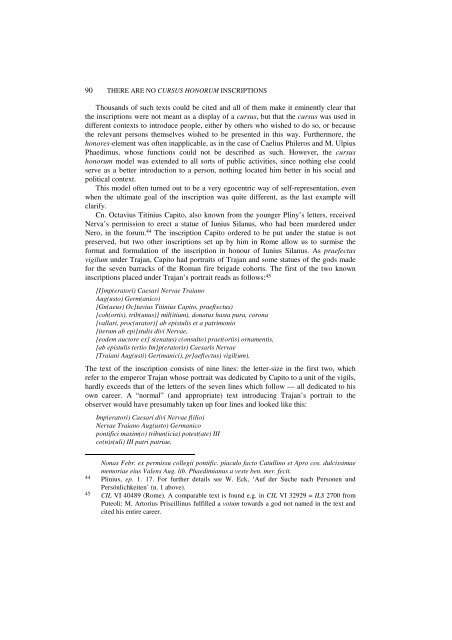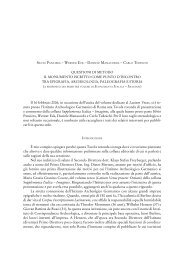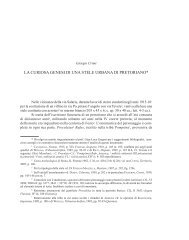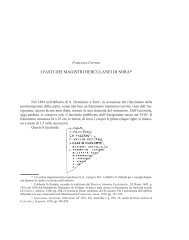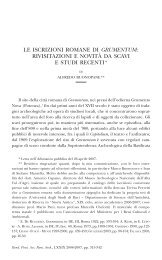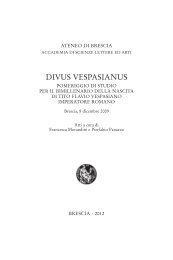There Are No cursus honorum Inscriptions. The Function of the ...
There Are No cursus honorum Inscriptions. The Function of the ...
There Are No cursus honorum Inscriptions. The Function of the ...
Create successful ePaper yourself
Turn your PDF publications into a flip-book with our unique Google optimized e-Paper software.
90 THERE ARE NO CURSUS HONORUM INSCRIPTIONS<br />
Thousands <strong>of</strong> such texts could be cited and all <strong>of</strong> <strong>the</strong>m make it eminently clear that<br />
<strong>the</strong> inscriptions were not meant as a display <strong>of</strong> a <strong>cursus</strong>, but that <strong>the</strong> <strong>cursus</strong> was used in<br />
different contexts to introduce people, ei<strong>the</strong>r by o<strong>the</strong>rs who wished to do so, or because<br />
<strong>the</strong> relevant persons <strong>the</strong>mselves wished to be presented in this way. Fur<strong>the</strong>rmore, <strong>the</strong><br />
honores-element was <strong>of</strong>ten inapplicable, as in <strong>the</strong> case <strong>of</strong> Caelius Phileros and M. Ulpius<br />
Phaedimus, whose functions could not be described as such. However, <strong>the</strong> <strong>cursus</strong><br />
<strong>honorum</strong> model was extended to all sorts <strong>of</strong> public activities, since nothing else could<br />
serve as a better introduction to a person, nothing located him better in his social and<br />
political context.<br />
This model <strong>of</strong>ten turned out to be a very egocentric way <strong>of</strong> self-representation, even<br />
when <strong>the</strong> ultimate goal <strong>of</strong> <strong>the</strong> inscription was quite different, as <strong>the</strong> last example will<br />
clarify.<br />
Cn. Octavius Titinius Capito, also known from <strong>the</strong> younger Pliny’s letters, received<br />
Nerva’s permission to erect a statue <strong>of</strong> Iunius Silanus, who had been murdered under<br />
Nero, in <strong>the</strong> forum. 44 <strong>The</strong> inscription Capito ordered to be put under <strong>the</strong> statue is not<br />
preserved, but two o<strong>the</strong>r inscriptions set up by him in Rome allow us to surmise <strong>the</strong><br />
format and formulation <strong>of</strong> <strong>the</strong> inscription in honour <strong>of</strong> Iunius Silanus. As praefectus<br />
vigilum under Trajan, Capito had portraits <strong>of</strong> Trajan and some statues <strong>of</strong> <strong>the</strong> gods made<br />
for <strong>the</strong> seven barracks <strong>of</strong> <strong>the</strong> Roman fire brigade cohorts. <strong>The</strong> first <strong>of</strong> <strong>the</strong> two known<br />
inscriptions placed under Trajan’s portrait reads as follows: 45<br />
[I]mp(eratori) Caesari Nervae Traiano<br />
Aug(usto) Germ(anico)<br />
[Gn(aeus) Oc]tavius Titinius Capito, praef(ectus)<br />
[coh(ortis), trib(unus)] mil(itium), donatus hasta pura, corona<br />
[vallari, proc(urator)] ab epistulis et a patrimonio<br />
[iterum ab epi]stulis divi Nervae,<br />
[eodem auctore ex] s(enatus) c(onsulto) praet(oriis) ornamentis,<br />
[ab epistulis tertio Im]p(eratoris) Caesarìs Nervae<br />
[Traiani Aug(usti) Ger(manici), pr]aef(ectus) vigil(um).<br />
<strong>The</strong> text <strong>of</strong> <strong>the</strong> inscription consists <strong>of</strong> nine lines: <strong>the</strong> letter-size in <strong>the</strong> first two, which<br />
refer to <strong>the</strong> emperor Trajan whose portrait was dedicated by Capito to a unit <strong>of</strong> <strong>the</strong> vigils,<br />
hardly exceeds that <strong>of</strong> <strong>the</strong> letters <strong>of</strong> <strong>the</strong> seven lines which follow — all dedicated to his<br />
own career. A “normal” (and appropriate) text introducing Trajan’s portrait to <strong>the</strong><br />
observer would have presumably taken up four lines and looked like this:<br />
Imp(eratori) Caesari divi Nervae f(ilio)<br />
Nervae Traiano Aug(usto) Germanico<br />
pontifici maxim(o) tribun(icia) potest(ate) III<br />
co(n)s(uli) III patri patriae,<br />
<strong>No</strong>nas Febr. ex permissu collegii pontific. piaculo facto Catullino et Apro cos. dulcissimae<br />
memoriae eius Valens Aug. lib. Phaedimianus a veste ben. mer. fecit.<br />
44 Plinius, ep. 1. 17. For fur<strong>the</strong>r details see W. Eck, ‘Auf der Suche nach Personen und<br />
Persönlichkeiten’ (n. 1 above).<br />
45 CIL VI 40489 (Rome). A comparable text is found e.g. in CIL VI 32929 = ILS 2700 from<br />
Puteoli: M. Artorius Priscillinus fulfilled a votum towards a god not named in <strong>the</strong> text and<br />
cited his entire career.


